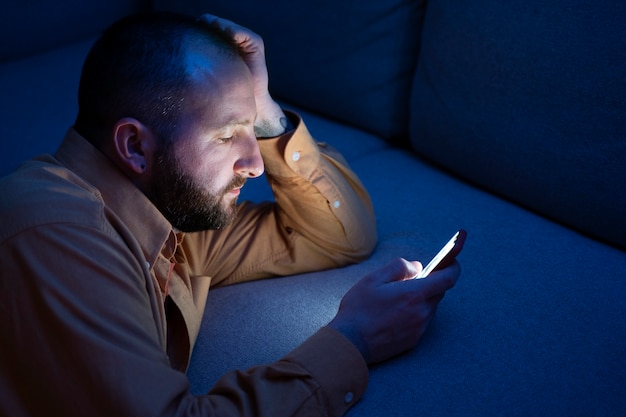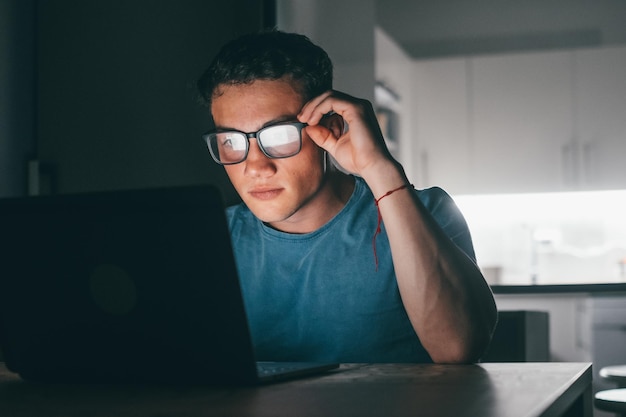The Impact of Blue Light on Your Eyes: Protect Your Vision in the Digital Age

The impact of blue light on your eyes, stemming from digital devices and artificial lighting, is a growing concern, but understanding its effects and adopting protective measures can significantly safeguard your vision in today’s technology-driven world.
In today’s digital age, we’re constantly surrounded by screens, from smartphones and tablets to computers and televisions. While these devices have undoubtedly revolutionized the way we live and work, they also emit blue light, a type of high-energy visible light that can have a significant **impact of blue light on your eyes**. Understanding the potential risks and taking proactive steps to protect your vision is crucial for maintaining long-term eye health.
Understanding Blue Light: What It Is and Where It Comes From
Blue light is a high-energy, short-wavelength light that is part of the visible light spectrum. While it’s naturally present in sunlight, it’s also emitted by artificial sources like LED screens, fluorescent lights, and smartphones. Understanding its origins is the first step in mitigating potential risks.
Natural Sources of Blue Light
The sun is by far the biggest source of blue light. During the day, sunlight exposes us to significant amounts of blue light, which, in moderation, can have some positive effects, such as boosting alertness and improving mood.
Artificial Sources of Blue Light
Beyond the sun, digital screens are significant producers of blue light. Our increasing reliance on these devices means we’re chronically exposed, which can lead to various forms of eye strain.
- LED and fluorescent lighting
- Computer screens
- Smartphone and tablet displays
- Television screens

Ultimately, comprehending the dual sources of blue light is pivotal for managing your exposure levels. While it would be unrealistic to completely avoid exposure, awareness of the sources allows for the adoption of strategies to reduce potential harm.
The Impact of Blue Light on Your Eyes: Potential Risks
Overexposure to blue light can cause a range of problems. While it is not necessarily inherently harmful, the chronic nature of its ubiquity in modern life is concerning. Understanding specific risks is the foundation for proactive eye care.
Digital Eye Strain
Prolonged screen time is frequently associated with digital eye strain. This issue includes various symptoms which often present together, making it uniquely troublesome.
Sleep Disruption
Blue light may disrupt the sleep cycle by suppressing melatonin production. Melatonin is the hormone responsible for inducing feelings of sleepiness. Its production is inhibited by light, particularly blue light.
- Difficulty falling asleep
- Poor sleep quality
- Daytime fatigue
- Insomnia
By understanding how blue light interferes with the natural sleep cycle, steps can be taken to ensure a restful night’s sleep. This proactive approach helps in overall eye and general health.

Protective Measures: Shielding Your Eyes from Blue Light
Luckily, there are several ways to minimize your exposure to blue light. Simple changes to tech use, or small purchases, can add up to make a big difference in your eye health in the long run.
Blue Light Blocking Glasses
These glasses have special lenses that filter out blue light, reducing the amount that reaches your eyes. They can be worn whenever you use digital devices, offering continuous protection.
Screen Filters
These filters can be applied directly to the screens of your devices. Like blue light blocking glasses, screen filters reduce the amount of blue light emitted by the screen. These can be easily purchased online.
- Reduce screen brightness
- Use blue light filter settings on devices
- Increase font size for easier reading
- Take regular breaks from screens
Blue Light Filters on Devices
Most smartphones and computers now have built-in blue light filter settings. These filters adjust the color temperature of the screen, reducing the amount of blue light emitted, particularly during evening hours. Using blue light filters while working long hours can help.
Adjusting Screen Brightness
Reducing the brightness of your screen can also help minimize blue light exposure. Bright screens emit more blue light. Lowering the brightness can reduce the strain on your eyes and improve comfort.
Regular Breaks: The 20-20-20 Rule
One of the simplest and most effective ways to protect your eyes is to take regular breaks. The 20-20-20 rule encourages you to look at an object 20 feet away for 20 seconds every 20 minutes.
- Prevent eye strain and dryness
- Reduce fatigue
- Improve focus
Implementing these protective measures in daily life can significantly reduce the negative impact of blue light on your eyes. By addressing exposure and making conscious adjustments, it’s possible to maintain better long-term eye health naturally.
Diet and Lifestyle: Supporting Eye Health Through Nutrition
While protecting your eyes from external factors like blue light is essential, diet and lifestyle play pivotal roles in maintaining optimal eye health. Here are some dietary and lifestyle choices that can support your vision.
Antioxidant-Rich Foods
Antioxidants help protect the eyes from damage caused by free radicals. Including plenty of fruits and vegetables rich in antioxidants can support eye health. Many of the most useful antioxidants also have other useful properties.
Omega-3 Fatty Acids
Omega-3 fatty acids are essential fats that contribute to overall eye health. Foods high in omega-3s can help reduce the risk of macular degeneration and dry eye syndrome.
- Eat a balanced diet
- Stay hydrated
- Get regular eye exams
- Avoid smoking
By incorporating these dietary and lifestyle changes, you can provide your eyes with the nutrients and support, thus improving overall eye health.
By eating a balanced diet, staying hydrated, wearing good sunglasses, getting regular checkups, and avoiding smoking, you help set yourself up for a lifetime good eye health.
| Key Point | Brief Description |
|---|---|
| 💡 Blue Light Sources | Sun and digital screens emit blue light. |
| 🛡️ Protective Measures | Use blue light glasses and screen filters. |
| ⏰ Regular Breaks | Follow the 20-20-20 rule to minimize strain. |
| 🍎 Eye Health Diet | Eat foods rich in antioxidants and omega-3s. |
Frequently Asked Questions
▼
Blue light is high-energy visible light emitted by digital screens and the sun. Overexposure can cause digital eye strain, disrupt sleep patterns, and may contribute to long-term vision problems.
▼
Blue light blocking glasses have lenses that filter out a portion of blue light. By reducing the amount of blue light reaching your eyes, these glasses can alleviate eye strain and fatigue.
▼
Adjust device settings to turn on blue light filters, lower screen brightness, and use screen filters. Regular breaks, like the 20-20-20 rule, can provide immediate relief to eyes.
▼
Symptoms can include dry eyes, blurred vision, headaches, and neck pain. These symptoms often arise after prolonged use of digital devices and are directly related to blue light exposure.
▼
Yes, foods high in antioxidants and omega-3 fatty acids can support eye health. Prioritizing a balanced diet can provide essential nutrients and reduce the risk of vision issues linked to blue light exposure.
Conclusion
Protecting your eyes from the impact of blue light on your eyes is crucial in the digital age. By understanding the sources and risks associated with blue light, you can take preventive measures to safeguard your vision and maintain long-term eye health. Implementing strategies such as using blue light blocking glasses, adjusting device settings, eating a balanced diet, and scheduling regular eye exams can significantly contribute to your overall well-being.
